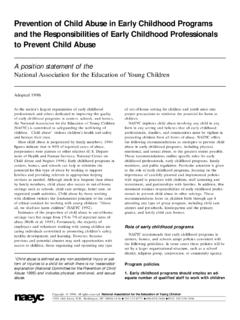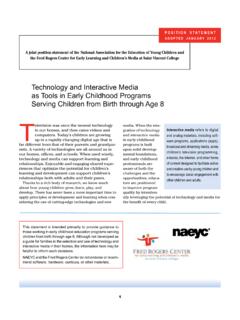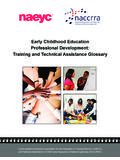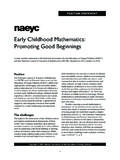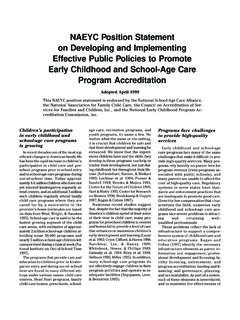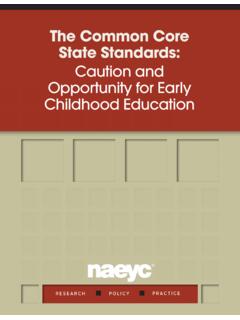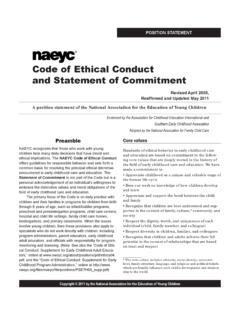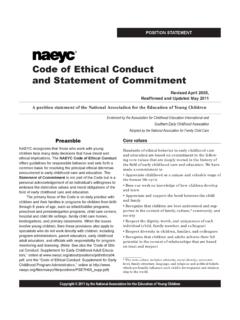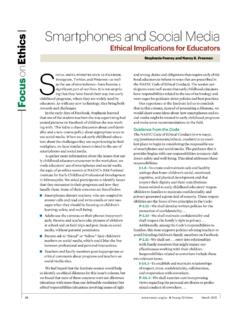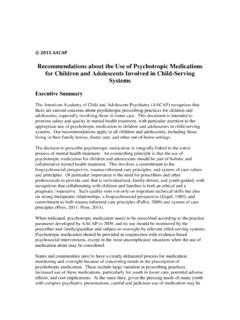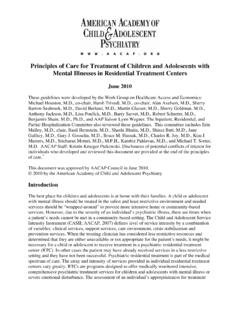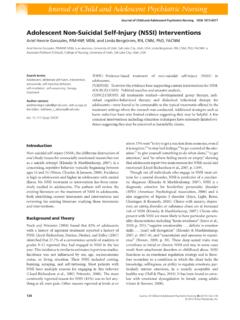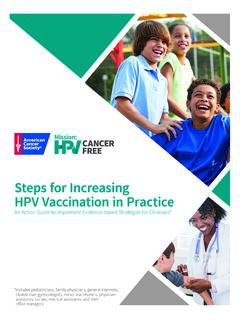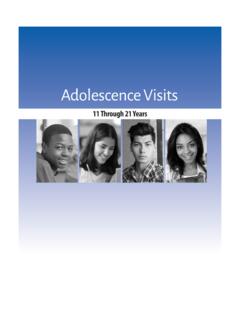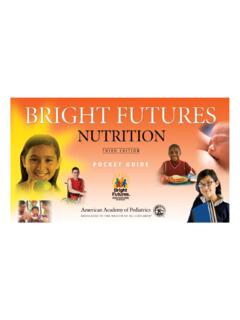Transcription of Learning to Read and Write: Developmentally Appropriate ...
1 Adopted May 1998A joint position statement of the International Reading Association and theNational Association for the Education of Young ChildrenLearning to Read and Write: Developmentally AppropriatePractices for Young ChildrennaeycCopyright 1998. All rights reserved. National Association for the Education of Young Children. In Young Children, July 1998, 53 (4): 30 16th Street, , Washington, DC 20036-1426 l 202-232-8777 l 800-424-2460 l FAX: 202-328-1846 Learning to read and write is critical to a child s success inschool and later in life. One of the best predictors of whether achild will function competently in school and go on to contrib-ute actively in our increasingly literate society is the level towhich the child progresses in reading and writing. Althoughreading and writing abilities continue to develop throughout thelife span, the early childhood years from birth through ageeight are the most important period for literacy is for this reason that the International Reading Association(IRA) and the National Association for the Education of YoungChildren (NAEYC) joined together to formulate a position state-ment regarding early literacy development.
2 The statement con-sists of a set of principles and recommendations for teachingpractices and public primary purpose of this position statement is to pro-vide guidance to teachers of young children in schools and earlychildhood programs (including child care centers, preschools,and family child care homes) serving children from birth throughage eight. By and large, the principles and practices suggestedhere also will be of interest to any adults who are in a positionto influence a young child s Learning and development parents, grand-parents, older siblings, tutors, and other community work in schools or programs regulated by adminis-trative policies as well as available resources. Therefore sec-ondary audiences for this position statement are school princi-pals and program administrators whose roles are critical inestablishing a supportive climate for sound, developmentallyappropriate teaching practices; and policymakers whose deci-sions determine whether adequate resources are available forhigh-quality early childhood great deal is known about how young children learn toread and write and how they can be helped toward literacy duringthe first five years of life.
3 A great deal is known also about howto help children once compulsory schooling begins, whether inkindergarten or the primary grades. Based on a thorough re-view of the research, this document reflects the commitment oftwo major professional organizations to the goal of helpingchildren learn to read well enough by the end of third grade sothat they can read to learn in all curriculum areas. IRA andNAEYC are committed not only to helping young children learnto read and write but also to fostering and sustaining their in-terest and disposition to read and write for their own enjoy-ment, information, and , the statement summarizes the current issues that arethe impetus for this position; then it reviews what is knownfrom research on young children s literacy development. Thisreview of research as well as the collective wisdom and experi-ence of IRA and NAEYC members provides the basis for a po-sition statement about what constitutes Developmentally ap-propriate practice in early literacy over the period of birththrough age eight.
4 The position concludes with recommenda-tions for teaching practices and of the issuesWhy take a position on something as obviously importantas children s Learning to read and write? The IRA and NAEYC believe that this position statement will contribute significantlyto an improvement in practice and the development of support-This joint NAEYC/IRA position statement is endorsed by the following organizations: american Speech-Language-Hearing Association, Association for Childhood Education International, Association ofTeacher Educators, Council for Early Childhood Professional Recognition, Division for Early child -hood/Council for Exceptional Children, National Association of Early Childhood Specialists in StateDepartments of Education, National Association of Early Childhood Teacher Educators, NationalAssociation of Elementary School Principals, National Association of State Directors of Special Education,National Council of Teachers of English, Zero to Three/National Center for Infants, Toddlers, & concepts in this joint position statement are supported by the following organizations.
5 Ameri-can academy of Pediatrics, american Association of School Administrators, american EducationalResearch Association, and the National Head Start to Read and Write: Developmentally Appropriate Practices for Young Childrenpage 2 of 16A position statement of the International Reading Association and the National Association for the Education of Young ChildrenCopyright 1998. All rights reserved. National Association for the Education of Young Children. In Young Children, July 1998, 53 (4): 30 16th Street, , Washington, DC 20036-1426 l 202-232-8777 l 800-424-2460 l FAX: 202-328-1846ive educational policies. The two associations saw that a clear,concise position statement was needed at this time for severalreasons. It is essential and urgent to teach children to read andwrite competently, enabling them to achieve today shigh standards of the United States enjoys the highest literacy ratein its history, society now expects virtually everyone in thepopulation to function beyond the minimum standards of lit-eracy.
6 Today the definition of basic proficiency in literacy callsfor a fairly high standard of reading comprehension and analy-sis. The main reason is that literacy requirements of most jobshave increased significantly and are expected to increase fur-ther in the future. Communications that in the past were verbal(by phone or in person) now demand reading and writing messages sent by electronic mail, Internet, or facsimile as wellas print documents. With the increasing variation among young children inour programs and schools, teaching today has becomemore teachers throughout the United States reportthat the children they teach today are more diverse in their back-grounds, experiences, and abilities than were those they taughtin the past. Kindergarten classes now include children who havebeen in group settings for three or four years as well as chil-dren who are participating for the first time in an organizedearly childhood program.
7 Classes include both children withidentified disabilities and children with exceptional abilities,children who are already independent readers and children whoare just beginning to acquire some basic literacy knowledge andskills. Children in the group may speak different languages atvarying levels of proficiency. Because of these individual andexperiential variations, it is common to find within a kinder-garten classroom a five-year range in children s literacy-relatedskills and functioning (Riley 1996). What this means is that somekindergartners may have skills characteristic of the typical three-year-old, while others might be functioning at the level of thetypical eight-year-old. Diversity is to be expected and embraced,but it can be overwhelming when teachers are expected to pro-duce uniform outcomes for all, with no account taken of theinitial range in abilities, experiences, interests, and personali-ties of individual children.
8 Among many early childhood teachers, a maturationistview of young children s development persists despitemuch evidence to the readiness view of reading development assumes that thereis a specific time in the early childhood years when the teach-ing of reading should begin. It also assumes that physical andneurological maturation alone prepare the child to take advan-tage of instruction in reading and writing. The readiness per-spective implies that until children reach a certain stage ofmaturity all exposure to reading and writing, except perhapsbeing read stories, is a waste of time or even potentially harm-ful. Experiences throughout the early childhood years, birththrough age eight, affect the development of literacy. Theseexperiences constantly interact with characteristics of individualchildren to determine the level of literacy skills a child ultimatelyachieves.
9 Failing to give children literacy experiences until theyare school age can severely limit the reading and writing levelsthey ultimately attain. Recognizing the early beginnings of literacy acquisitiontoo often has resulted in use of inappropriate teachingpractices suited to older children or adults perhaps butineffective with children in preschool, kindergarten, andthe early practices associated with outdated views of literacydevelopment and/or Learning theories are still prevalent in manyclassrooms. Such practices include extensive whole-group in-struction and intensive drill and practice on isolated skills forgroups or individuals. These practices, not particularly effec-tive for primary-grade children, are even less suitable and ef-fective with preschool and kindergarten children. Young chil-dren especially need to be engaged in experiences that makeacademic content meaningful and build on prior Learning .
10 It isvital for all children to have literacy experiences in schools andearly childhood programs. Such access is even more critical forchildren with limited home experiences in literacy. However,these school experiences must teach the broad range of lan-guage and literacy knowledge and skills to provide the solidfoundation on which high levels of reading and writing ultimatelydepend. Current policies and resources are inadequate in ensur-ing that preschool and primary teachers are qualifiedto support the literacy development of all children, atask requiring strong preservice preparation and on-going professional teachers of children younger than kindergarten age inthe United States, no uniform preparation requirements or li-censure standards exist. In fact, a high school diploma is thehighest level of education required to be a child care teacher inmost states.
